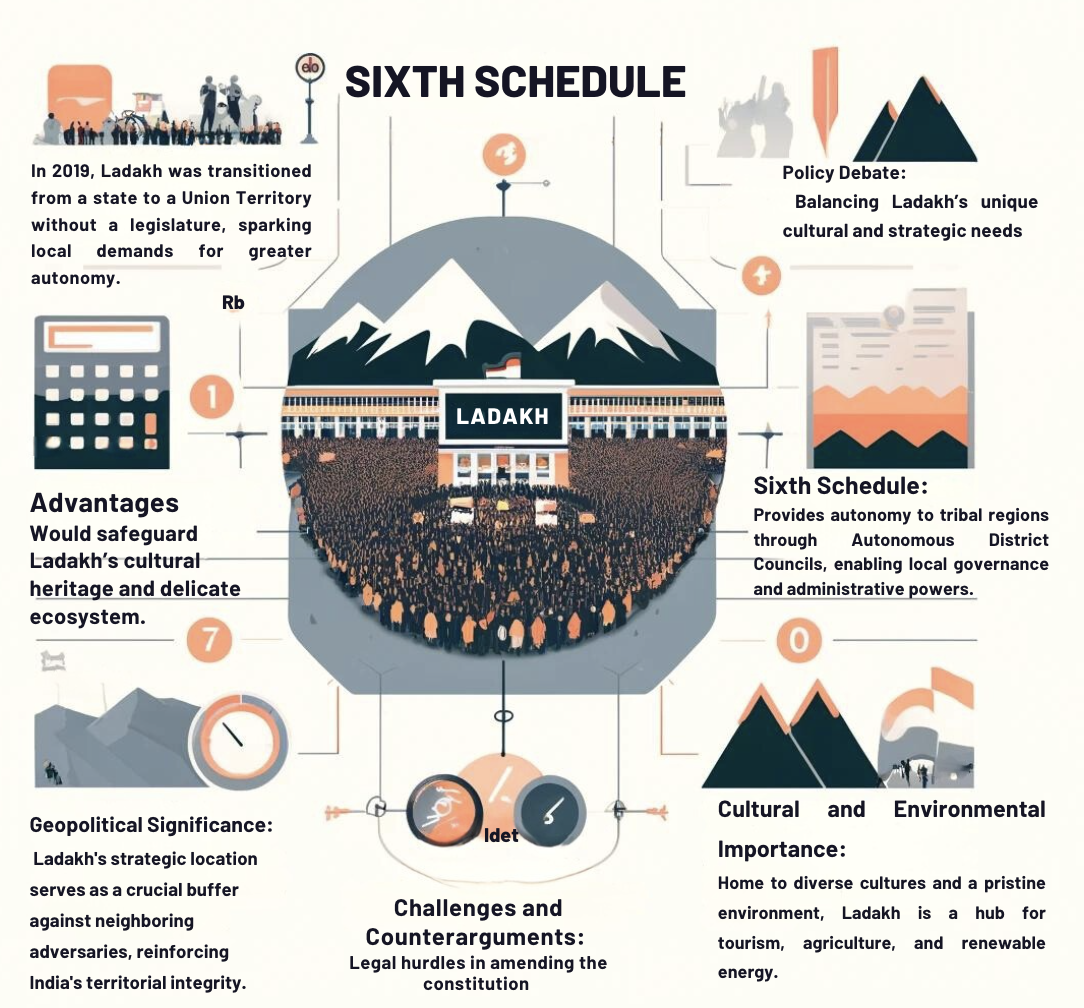
In recent developments, Ladakh has become a focal point of protests aimed at restoring its statehood and safeguarding its distinct identity within the constitutional framework. These protests stem from the decision in 2019 to reclassify Ladakh as a Union territory without a legislature.
The demonstrators are advocating for Ladakh’s reinstatement as a full-fledged state, a status it held prior to the aforementioned reclassification. Additionally, there is a demand for Ladakh to be accorded the status of a tribal area under the Sixth Schedule of the Constitution. This designation would provide for enhanced local autonomy and protections for the region’s unique cultural and demographic characteristics.
- Preservation of Cultural Identity
- Socio-Economic Development
- Democratic Institutions
- Environmental and Border Security Concerns
Significance of Ladakh for India
Geopolitical Importance
- Known as “the Land of Passes”, Ladakh’s strategic location at the crossroads of South Asia, Central Asia, and East Asia holds immense geopolitical significance.
Strategic Significance
- Acts as a buffer zone between India and neighboring countries like China and Pakistan, crucial for safeguarding India’s territorial integrity and sovereignty.
- Indian Armed Forces maintain a strong presence in Ladakh to counter external threats and protect borders.
Tourism Potential
- Referred to as Lama Land or Little Tibet, Ladakh offers diverse attractions from trekking and mountaineering to Buddhist monastery tours.
Economic Importance
- Ladakh holds vast untapped economic potential, particularly in tourism, agriculture, and renewable energy sectors.
- Breathtaking landscapes, including Pangong and Tso Moriri lakes, draw tourists seeking adventure and tranquility.
Environmental Significance
- Fertile valleys and river basins in Ladakh present opportunities for agricultural development, including organic farming and horticulture.
- Abundant sunlight and wind resources make Ladakh suitable for solar and wind energy projects, aligning with India’s renewable energy goals.
Cultural Significance
- Situated along the ancient Silk Route, Ladakh played a vital role in the development of culture, religion, and trade.
- Home to diverse ethnic communities like Ladakhi, Tibetan, and Balti, each with distinct traditions.
- Centuries-old monasteries like Hemis, Thiksey, and Diskit serve as spiritual and cultural centers, preserving Buddhist teachings and practices.

Ladakh’s Demand for Inclusion in the 6th Schedule
Ensuring Representation
- Before 2019, Ladakh had significant representation in Jammu and Kashmir’s legislative assembly.
- Now, as a Union Territory without a legislative assembly, there are concerns about loss of local autonomy and decision-making power.
- The Ladakh Autonomous Hill Development Council (LAHDC), once autonomous, now feels marginalized under direct central government rule.
- Fear of outsiders making decisions for Ladakh without proper representation.
Lack of Public Participation
- Ladakh previously enjoyed special status under Article 370 and Article 35A, providing safeguards for jobs, land, and culture.
- Now, without a legislative body, decisions are made bureaucratically, reducing public participation.
- Insecurity grows due to the absence of safeguards for Ladakh’s identity and culture.
Ladakh’s Fragile Ecosystem
- Ladakh’s ecosystem is fragile, comprising high-altitude deserts, glaciers, and alpine meadows, rich in biodiversity.
- Concerns arise over mining in glacial areas, threatening the delicate balance of the ecosystem.
- Fear that industrialization will strain the ecosystem beyond its capacity, impacting livelihoods and the region’s water resources.
Sensitive Borders
- Ladakh shares borders with China and Pakistan, facing security challenges due to the ongoing military standoff with China and Pakistan’s efforts to stoke tensions.
- Local support is crucial for strategic infrastructure development to address security concerns.
Preservation of Cultural Identity
- Inclusion in the Sixth Schedule would legally safeguard Ladakh’s unique cultural heritage and traditional customs.
- Empowering tribal communities under the Sixth Schedule enables self-governance and resource management, preserving Ladakh’s identity.
Performance of Socio-Economic Development
- Critics highlight deficiencies in employment generation and lack of a comprehensive job policy under the Union Territory administration.
- The absence of a public service commission and job policy has led to discontent among the youth.
- Sixth Schedule autonomy could facilitate locally relevant development initiatives, enhancing socio-economic outcomes.
Strengthening of Democratic Institutions
- Autonomous councils under the Sixth Schedule would strengthen grassroots democratic institutions, promoting inclusive governance and accountability.
The Way Forward for Ladakh:
Meaningful Dialogue:
- Government should talk with Ladakh’s locals, political leaders, and organizations behind the protests.
- Understand why they want the Sixth Schedule status.
Assessment of Feasibility:
- Check if giving Ladakh Sixth Schedule status is doable.
- Look at legal, administrative, socio-economic, and cultural sides.
- Think about how it’ll affect governance, development, and security.
Gain Trust:
- Government promises need to be real and happen within a clear timeframe.
- The process should adapt to changes.
Enhance Local Governance:
- Give more power to local government.
- Focus on making policies that help Ladakh grow economically and protect its culture.
Sensitive Policymaking:
- When making policies, remember Ladakh’s unique location, environment, resources, and what people want.
- Harmony is key to using Ladakh’s advantages well.
Gradual and Phased Approach:
- Because it’s a complex issue with many interests, decisions should happen slowly and in stages.
- Testing different options first could help figure out what works best before making big changes.
Conclusion
The ongoing discussion regarding Ladakh’s request for inclusion in the Sixth Schedule goes beyond mere constitutional deliberations; it speaks volumes about the region’s desire for acknowledgment, self-governance, and sustainable progress within the Indian Union. For those preparing for the UPSC exam, delving into the intricacies of this matter provides valuable insights into federalism, administration, and the delicate equilibrium between national security and local aspirations. Ladakh’s people aspire for recognition intertwined with strategic, environmental, and cultural importance, highlighting the governance complexities in India’s border regions. This situation offers a distinct opportunity for aspiring civil servants to contemplate inclusive governance principles and the significance of embracing diverse regional aspirations in our national policymaking. As India advances towards an inclusive development path, ensuring Ladakh’s representation and effectively addressing its concerns will not only strengthen national unity but also enhance India’s democratic principles and governance framework.

